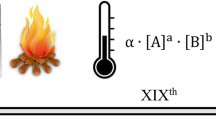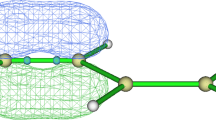Abstract
A new descriptor tool enabling to qualitatively identify excited-state potential energy regions with high decay probability is here disclosed and applied to analyze a photoinduced ring-opening reaction already well characterized from the experimental and theoretical point of view. The analysis based on such descriptor allows one to highlight a high probability of excited-state deactivation within the Franck–Condon region, in agreement with experiments, and to qualitatively indentify the main mechanisms providing efficient pathways of photoreactivity.




Similar content being viewed by others
References
Irie M, Fukaminato T, Sasaki T et al (2002) Organic chemistry: a digital fluorescent molecular photoswitch. Nature 420:759–760
Prager S, Burghardt I, Dreuw A (2014) Ultrafast CSpiro–O dissociation via a conical intersection drives spiropyran to merocyanine photoswitching. J Phys Chem A 118:1339–1349
Fukaminato T (2011) Single-molecule fluorescence photoswitching: design and synthesis of photoswitchable fluorescent molecules. J Photochem Photobiol C Photochem Rev 12:177–208
Bernardi F, Olivucci M, Robb MA (1996) Potential energy surface crossings in organic photochemistry. Chem Soc Rev 25:321–328
Bearpark MJ, Bernardi F, Clifford S et al (1996) The azulene S1 state decays via a conical intersection: a CASSCF study with MMVB dynamics. J Am Chem Soc 118:169–175
Wurzer AJ, Lochbrunner S, Riedle E (2000) Highly localized vibronic wavepackets in large reactive molecules. Appl Phys B Lasers Opt 71:405–409
Burland DM, Robinson GW (1970) Is the breakdown of the Born–Oppenheimer approximation responsible for internal conversion in large molecules? Proc Natl Acad Sci 66:257–264
Butler LJ (1998) Chemical reaction dynamics beyond the Born–Oppenheimer approximation. Annu Rev Phys Chem 49:125–171
Parr RG, Yang W (1989) Density-functional theory of atoms and molecules. Oxford University Press, Oxford
Savarese M, Aliberti A, De Santo I et al (2012) Fluorescence lifetimes and quantum yields of rhodamine derivatives: new insights from theory and experiment. J Phys Chem A 116:7491–7497
Savarese M, Raucci U, Netti PA et al (2014) Modeling of charge transfer processes to understand photophysical signatures: the case of rhodamine 110. Chem Phys Lett 610:148–152
Savarese M, Raucci U, Adamo C et al (2014) Non-radiative decay paths in rhodamines: new theoretical insights. Phys Chem Chem Phys 16:20681–20688
Savarese M, Brémond É, Antonov L et al (2015) Computational insights on the excited state proton transfer reactions in azo and azomethine dyes. ChemPhysChem 16:3966–3973
Le Bahers T, Adamo C, Ciofini I (2011) A qualitative index of spatial extent in charge-transfer excitations. J Chem Theory Comput 7:2498–2506
Adamo C, Le Bahers T, Savarese M et al (2015) Exploring excited states using time dependent density functional theory and density-based indexes. Coord Chem Rev 304–305:166–178
Savarese M, Brémond É, Adamo C et al (2016) Excited state proton transfer and intramolecular charge transfer in 1, 3 diketone molecules: a density functional theory based investigation. ChemPhysChem 17:1530–1538
Wilbraham L, Savarese M, Rega N et al (2014) Describing excited state intramolecular proton transfer (ESIPT) in dual emissive systems: a density functional theory based analysis. J Phys Chem B 119:2459–2466
Savarese M, Netti PA, Adamo C et al (2013) Exploring the metric of excited state proton transfer reactions. J Phys Chem B 117:16165–16173
Raucci U, Savarese M, Adamo C et al (2015) Intrinsic and dynamical reaction pathways of an excited state proton transfer. J Phys Chem B 119:2650–2657
Rini M, Holm A-K, Nibbering ETJ, Fidder H (2003) Ultrafast UV-mid-IR investigation of the ring opening reaction of a photochromic spiropyran. J Am Chem Soc 125:3028–3034
Ernsting NP (1989) Transient optical absorption spectroscopy of the photochemical spiropyran-merocyanine conversion. Chem Phys Lett 159:526–531
Ernsting NP, Dick B, Arthen-Engeland T (1990) The primary photochemical reaction step of unsubstituted indolino-spiropyrans. Pure Appl Chem 62:1483–1488
Liu F, Morokuma K (2013) Multiple pathways for the primary step of the spiropyran photochromic reaction: a CASPT2//CASSCF study. J Am Chem Soc 135:10693–10702
Liu F, Kurashige Y, Yanai T, Morokuma K (2013) Multireference Ab initio density matrix renormalization group (DMRG)-CASSCF and DMRG-CASPT2 study on the photochromic ring opening of spiropyran. J Chem Theory Comput 9:4462–4469
Zhai G-H, Yang P, Wu S-M et al (2014) A semiclassical molecular dynamics of the photochromic ring-opening reaction of spiropyran. Chin Chem Lett 25:727–731
Sheng Y, Leszczynski J, Garcia AA et al (2004) Comprehensive theoretical study of the conversion reactions of spiropyrans: substituent and solvent effects. J Phys Chem B 108:16233–16243
Yanai T, Tew DP, Handy NC (2004) A new hybrid exchange–correlation functional using the Coulomb-attenuating method (CAM-B3LYP). Chem Phys Lett 393:51–57
Pedone A (2013) Role of solvent on charge transfer in 7-aminocoumarin dyes: new hints from TD-CAM-B3LYP and state specific PCM calculations. J Chem Theory Comput 9:4087–4096
Guido CA, Jacquemin D, Adamo C, Mennucci B (2015) Electronic excitations in solution: the interplay between state specific approaches and a time-dependent density functional theory description. J Chem Theory Comput 11:5782–5790
Barbatti M, Aquino AJA, Lischka H et al (2009) Ultrafast internal conversion pathway and mechanism in 2-(2′-hydroxyphenyl) benzothiazole: a case study for excited-state intramolecular proton transfer systems. Phys Chem Chem Phys 11:1406–1415
Savarese M, Netti PA, Rega N et al (2014) Intermolecular proton shuttling in excited state proton transfer reactions: insights from theory. Phys Chem Chem Phys 16:8661–8666
Heitler W (1954) The quantum theory of radiation, 3rd edn. Dover Publications, New York
Lax M (1952) The Franck–Condon principle and its application to crystals. J Chem Phys 20:1752–1760
Author information
Authors and Affiliations
Corresponding authors
Additional information
Published as part of the special collection of articles “Health & Energy from the Sun.”
Electronic supplementary material
Below is the link to the electronic supplementary material.
Rights and permissions
About this article
Cite this article
Savarese, M., Raucci, U., Netti, P.A. et al. A qualitative model to identify non-radiative decay channels: the spiropyran as case study. Theor Chem Acc 135, 211 (2016). https://doi.org/10.1007/s00214-016-1966-x
Received:
Accepted:
Published:
DOI: https://doi.org/10.1007/s00214-016-1966-x




